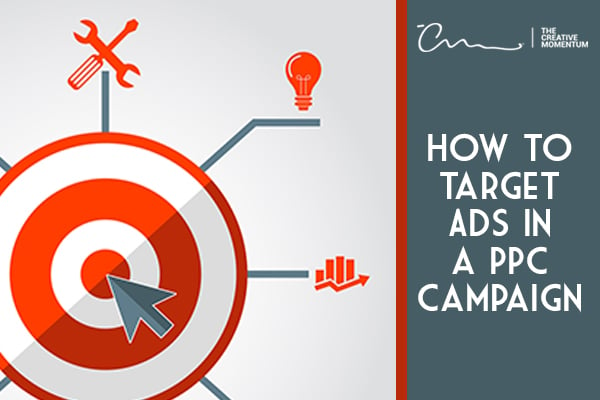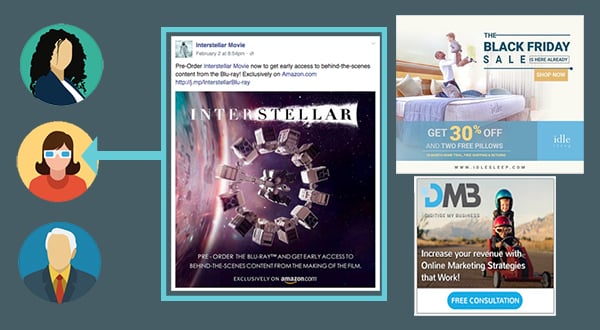
Once you’ve written the right copy and designed the perfect ad, you have to make sure it’s being seen by the right audience in the right place at the right time. That's a lot of rights.
This is where targeting comes in. Targeting ads is essential to a successful Pay-Per-Click (PPC) ad campaign, and Google Ads regularly comes up with new ways to target your ads.
You can target ads by search, audience, and content or a combination of all three. You can exclude or include keywords or audiences by different categories, such as life events, remarketing, location, and gender. Not all PPC campaigns rely on keywords, either. Some of the newest Google functions, such as Dynamic Search Ads, use your organic website content to determine the ads it displays.
Search Targeting
When you show an ad on a search engine results page (SERP) while users are actively searching, you’re using search targeting on your PPC ads. Because users are seeking information that you’ve provided in your ad, they might be more inclined to click on your ad. By bidding on keywords, you’re actively engaging in PPC search targeting.
 Audience Targeting
Audience Targeting
Audience targeting allows you to set precise parameters for who will see your ad. You can create a customized advanced audience list by combining your audience lists or excluding parts of your audience. Here are specific ways you can customize your audience:
- Demographics: Demographic audiences are created based on their location, age, gender, life events, parenting status, marital status, device, and more. You can customize your ad to include or exclude these demographics to get very specific with your marketing efforts.
- Affinity: Affinity audiences have the broadest reach on the Google Display Network. These audiences were created to mimic TV audiences and tend to be grouped broadly into categories like “YouTube influencers” or “social media enthusiasts.” These audiences are best used when you’re trying to reach a broad network of people.
- In-market: In-market ads are aimed at users who have been searching for products or services similar to what you’re selling. These aren’t your customers but instead are groups of people Google believes are in the market for a service or product similar to yours. This is an excellent way to reach customers who aren’t familiar with your product or service.
- Customer-intent: With customer-intent marketing, you can implement keywords, phrases, URLs, or YouTube content related to users who are more likely to engage with your website. This method is good to use on an in-market group you can’t quite convert or identify. You are adding custom keywords in this method, but Google is using them to identify potential customers who are likely to be interested in your products or services.
- Similar audiences: Similar audiences targets users with interests related to your customers’ interests. These people aren’t directly searching for your products or services, but they may be interested in your ads based on their similar interests.
- Remarketing: Remarketing focuses on users who have used your website or app in the past. Once they’ve gone to your website and left, they’ll see these ads pop up more frequently on their browser. They may have left your website at any stage of the conversion process, but when they see these ads, they might return to your website or app to complete their purchase. Dynamic remarketing takes this process one step farther by showing users the same products they viewed on your website over and over.
 Content Targeting
Content Targeting
On the other hand, content targeting, also called contextual targeting, allows you to target an individual based on a search query or online activity on the Google Display Network. For example, if a person is reading a blog about gardening, ads selling seeds or gardening tools might pop up on her screen.
Content targeting has advantages over other types of marketing, including:
- The ability to reach users who are unaware of your particular brand or service
- More relevant ads, which users are more likely to click on
- The ability to reach a broad, significant audience
Here are some specific ways you can use content targeting:
- Topic: Topic targeting allows you to reach a broad range of pages at once on the Google Display Network. Google Ads analyzes your website content and considers factors such as language, link structure, and page structure. It then determines the central themes of each webpage and targets ads to potential customers based on your topic selections.
- Placement: Placement targeting doesn’t require the use of keywords and instead targets websites on the Google Display Network that your customers visit. A placement ad might be an entire website or a subset of a website.
- Content keywords: Content keywords that are relevant to your product or service allow you to target users searching for similar content using those same keywords. You can tailor a set of keywords to manually reach a certain demographic or topic or to meet specific goals. For example, you might change your keywords to reflect a seasonal sale like Black Friday only during a certain timeframe and location.
- Smart targeting: One of the easiest and most efficient ways to get great performance from your PPC campaign is to expand your targeting reach automatically with smart targeting. Smart targeting predicts user behaviors with automated technology. In Google Ads display campaigns, Google uses smart targeting in its targeting expansion feature. This allows Google to find for your website those valuable customers who convert more easily. Targeting expansion offers more control and forecasting and makes it easier for you to predict your ad performance. You can learn more about using Google’s smart campaigns in our blog, Are Your Google PPC Campaigns Smart?
Get Help Targeting Your PPC Ads
There are so many ways to target your PPC ad it can make your head spin. Correctly targeting your PPC ad can make as much difference in its success as the ad's content or design.
Do you need help with targeting your PPC ads? We can help. Contact us and let us know more about your PPC goals.


